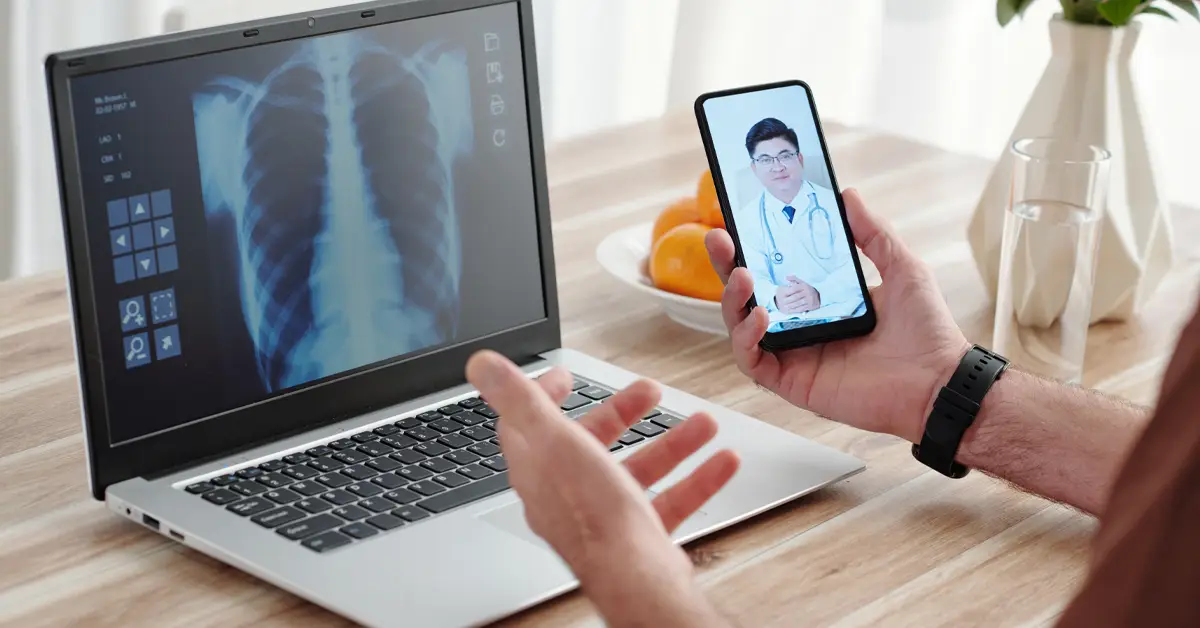According to the World Health Organization, Chronic Obstructive Pulmonary Disease (COPD) is a progressive, long-term lung disease that affects millions of people worldwide, and is the third leading cause of death. It is characterized by persistent respiratory symptoms, frequent exacerbations, and reduced lung function. Effective self-management is essential for people with COPD to manage their disease, improve their quality of life, and reduce the frequency of exacerbations.
Traditionally, COPD self-management has relied on pulmonary rehabilitation programs, patient education, and in-person visits with healthcare providers. However, with the advent of remote patient monitoring technologies, there is a growing interest in exploring how these tools can support and enhance COPD self-management. In this article, we will discuss the current state of COPD self-management, the evolution of self-management approaches, and the potential benefits of remote patient monitoring for people with COPD.
Evolution of COPD Self-Management Program
The approach to COPD self-management has evolved significantly over the past few decades. Initially, the focus was on providing patients with education and information about their disease, with the goal of improving their understanding and ability to manage their symptoms. Over time, the emphasis shifted to providing structured self-management programs that included regular monitoring, goal setting, and behavioral change support.
Pulmonary rehabilitation programs have also become an important component of COPD self-management. These programs provide patients with exercise training, breathing techniques, and education to improve their physical functioning and reduce their symptoms. Additionally, many programs now incorporate self-management education and support, with the goal of empowering patients to manage their disease effectively.
In recent years, there has been a growing interest in the use of technology to support COPD self-management. Remote patient monitoring tools, such as wearable devices and telemedicine platforms, are being developed and tested to help patients manage their disease more effectively. These tools have the potential to provide real-time monitoring of respiratory symptoms, alert patients and their healthcare providers to worsening symptoms, and provide support for self-management activities, such as physical activity, breathing techniques, and medication management.
The evolution of COPD self-management highlights the growing recognition of the importance of empowering patients to manage their disease effectively, and the potential for technology to play a role in this process. As self-management approaches continue to evolve, it is important to consider how these new technologies can be integrated into existing care pathways to provide the most effective and efficient support for people with COPD.
The Benefits of Remote Patient Monitoring for Treatment of COPD
Remote patient monitoring (RPM) is a technology-driven approach to healthcare delivery that enables patients with COPD to self-manage their condition from the comfort of their homes. It has transformed how COPD is managed and treated. RPM offers several benefits over traditional self-management approaches, including:
- Real-time monitoring and tracking of vital signs: RPM technology provides real-time monitoring of patients’ vital signs, including pulse, oxygen levels, and breathing patterns, enabling healthcare providers to quickly identify and respond to any changes in the patient’s condition.
- Early detection of exacerbations: Early detection of exacerbations is crucial in managing COPD, and RPM provides patients with COPD the ability to quickly alert their healthcare providers of any changes in their symptoms, enabling prompt interventions.
- Improved self-management: RPM technology offers patients with COPD an interactive platform to engage in their own care, which empowers them to better manage their condition and improve their overall quality of life.
- Better coordination of care: RPM enables healthcare providers to collaborate more effectively and share information in real-time, improving the coordination of care and reducing the risk of adverse events.
- Cost-effectiveness: By reducing the need for in-person appointments and hospital admissions, RPM has the potential to significantly lower healthcare costs and improve the efficiency of care delivery.
The use of RPM in the self-management of COPD has shown promising results, and its benefits have been recognized by healthcare providers, patients, and payers alike. With the evolution of RPM technology, the future of COPD self-management looks bright, and its use will continue to expand in the years to come.
COPD Self-Management Plan
COPD self-management is crucial for people living with the condition to control their symptoms and maintain a good quality of life. A well-structured COPD self-management plan helps individuals to stay on track with their treatment and manage any exacerbations of the disease. The following are the key components of a COPD self-management plan:
- Understanding COPD: People with COPD should educate themselves about the condition, including the causes, symptoms, and available treatments.
- Monitoring Symptoms: Regular monitoring of symptoms such as coughing, wheezing, and shortness of breath is crucial to track the progression of the disease and detect any worsening of symptoms.
- Medication Management: Taking medications as prescribed is a critical aspect of COPD management. People with COPD should work with their healthcare provider to develop a medication plan that meets their specific needs.
- Pulmonary Rehabilitation: Pulmonary rehabilitation is a type of program that can help people with COPD improve their breathing and physical function.
- Healthy Lifestyle: Engaging in physical activity and maintaining a healthy diet can help people with COPD manage their symptoms and improve their overall well-being.
- Monitoring Exacerbations: People with COPD should be vigilant in identifying and managing exacerbations, which are episodes of worsening of their symptoms.
- Seeking Support: Support from family and friends, as well as support groups, can provide emotional and practical help for people with COPD.
Implementing Remote Patient Monitoring for COPD Self-Management
Remote patient monitoring (RPM) is a rapidly evolving field that has the potential to revolutionize the way people with COPD manage their disease. In order to effectively implement RPM for COPD self-management, healthcare providers need to take a comprehensive and patient-centered approach. This can be achieved by following these key steps:
- Selecting appropriate technology: There are many different types of RPM technologies available, including wearable devices, mobile apps, and telehealth platforms. Healthcare providers should select technologies that are best suited to the needs of their patients and the goals of their self-management plans.
- Educating patients: Patients need to be trained on how to use the technology, interpret the data, and use it to manage their disease effectively. This education should be provided by healthcare providers or trained RPM specialists.
- Monitoring and adjusting: Regular monitoring of patient progress is crucial for ensuring that the self-management plan remains effective. This may involve adjusting the technology, self-management strategies, or the overall care plan as needed.
- Collaboration: Collaboration between healthcare providers, patients, and RPM technology specialists is crucial for ensuring the success of RPM for COPD self-management. Regular communication and collaboration can help ensure that everyone involved is working towards the same goals and that patients are receiving the support they need to effectively manage their disease.
Revolutionizing COPD Self-Care with DrKumo RPM Technology
DrKumo‘s commitment to advancing remote patient monitoring and self-management of chronic conditions such as COPD aligns with the company’s mission to revolutionize the way people access quality healthcare. By utilizing state-of-the-art technology, DrKumo empowers patients with the tools necessary to manage their health conditions in the comfort of their own homes.
DrKumo is a technology leader in highly scalable, continuous, real-time remote patient monitoring solutions. The company offers a user-friendly solution that is powered by its HIPAA-compliant, mobile-enabled, real-time monitoring, and AI/ML engine. This technology provides healthcare providers with real-time intelligence for timely interventions, while enabling patients to manage their conditions from the comfort of their own homes.
In addition to COPD self-management, DrKumo’s remote patient monitoring solutions are designed to support acute care, post-operation, and hospital care at home. The company’s innovative and technology-driven culture has resulted in the development of the most effective solutions for both patients and healthcare providers.
DrKumo’s remote patient monitoring technology offers a number of benefits, including increased patient engagement, reduced hospital readmissions, and improved overall health outcomes. These benefits are particularly important for those with chronic conditions, such as COPD, where continuous monitoring and management is critical to maintaining health and wellness.
Takeaways
Chronic obstructive pulmonary disease (COPD) is a debilitating condition that can impact an individual’s daily life. However, with the evolution of self-management and the integration of remote patient monitoring, people with COPD can now have better control over their condition. A well-structured self-management plan and remote patient monitoring can help people with COPD to manage their symptoms and prevent exacerbations.
Implementing remote patient monitoring for COPD self-management can provide many benefits, including improved self-awareness, timely intervention, and better health outcomes. In conclusion, remote patient monitoring has the potential to revolutionize the way people with COPD manage their condition, leading to a better quality of life.
Considering using remote patient monitoring to take control of COPD and implement a personalized self-management plan that works for you? Contact DrKumo now.








